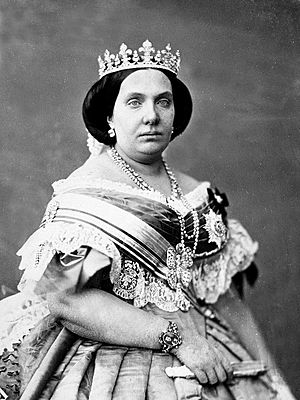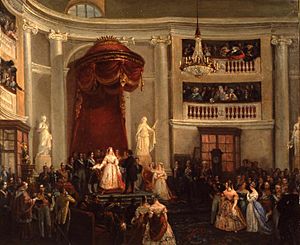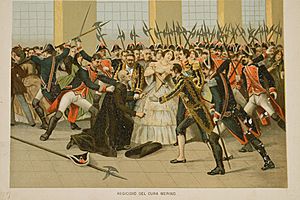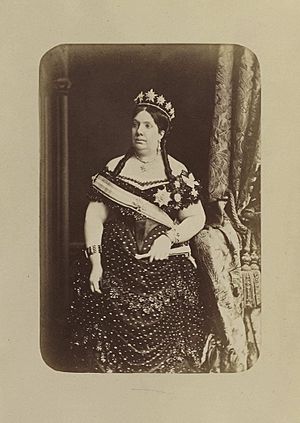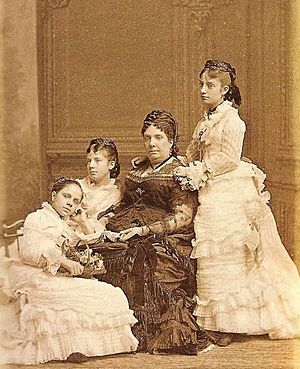Isabella II of Spain facts for kids
Isabella II (Spanish: Isabel II; 10 October 1830 – 9 April 1904) was the Queen of Spain from 1833 to 1868. She is the only queen who ruled Spain in her own right.
Isabella was the older daughter of King Ferdinand VII and Queen Maria Christina. Before Isabella was born, her father made a special rule to make sure his first daughter could become queen, since he didn't have a son. She became queen just before her third birthday. However, her uncle, Infante Carlos, disagreed with her becoming queen because she was a girl. This led to a series of wars called the Carlist Wars. During her childhood, her mother ruled for her. Spain changed from a country where the king had all the power to one with a constitution and parliament. Isabella's time as queen was often filled with political arguments and military uprisings. She was removed from power in 1868 and officially gave up her title in 1870. Her son, Alfonso XII, became king in 1874.
Contents
Becoming Queen of Spain
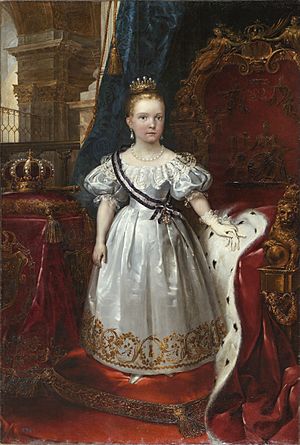
Isabella was born in the Royal Palace of Madrid in 1830. She was the oldest daughter of King Ferdinand VII of Spain and his fourth wife, Maria Christina of the Two Sicilies.
Isabella became queen because her father, King Ferdinand VII, changed the law. Before, only sons could inherit the throne. He wanted his daughter to be able to rule. His brother, Infante Carlos, Count of Molina, disagreed with this change. He believed he should be king. This disagreement led to the First Carlist War, which lasted seven years while Isabella was still a child. Supporters of Carlos were called Carlists.
Isabella's rule was kept strong by the army. The government, made up of Moderate Liberals and Progressives, created a constitutional government. They also took back property from religious groups and tried to fix Spain's money problems.
After the Carlist war, Isabella's mother, Maria Christina, stepped down as regent. Baldomero Espartero, Prince of Vergara, a popular general, became the new regent. He was a Progressive and ruled for two years.
In 1843, General Espartero was removed from power by other generals, Leopoldo O'Donnell and Ramón María Narváez. They formed a new government. This government convinced the parliament to declare Isabella old enough to rule on her own when she was just 13 years old.
Isabella's Rule as Adult Queen
Isabella was declared old enough to rule and swore to uphold the 1837 Constitution on 10 November 1843. She was 13 years old. Even though the parliament was supposed to be in charge, Isabella still had a lot of power in choosing and removing governments. This caused problems for the Progressive party.
Important Changes in Spain
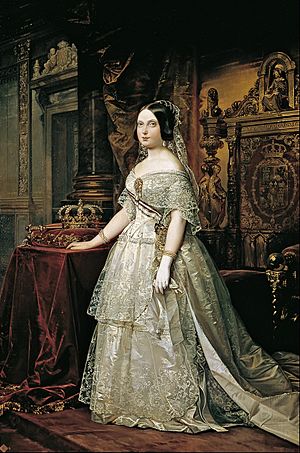
From 1844, the "Moderate Decade" began, led by Marshal Narváez. He was a very powerful general. The laws he created gave more power to the queen and less to the parliament.
On 10 October 1846, when she was 16, Isabella married her cousin, Francisco de Asís, Duke of Cádiz. On the same day, her younger sister, Infanta Luisa Fernanda, married Antoine d'Orléans. These marriages were important for France and its king, Louis Philippe, King of the French.
In 1847, Isabella showed her affection for General Serrano. This caused a scandal. To solve the problem, General Serrano was sent away from the capital. This event further damaged the queen's public image. After a period of unrest in 1848, Narváez was given special powers to stop any uprisings.
In 1851, Isabella had her first daughter, María Isabel Francisca de Asís.
On 2 February 1852, a priest named Martín Merino y Gómez tried to attack Queen Isabella with a knife as she was leaving the Royal Palace of Madrid. He was quickly caught and later executed.
By June 1854, the government was in trouble. On 28 June 1854, a military uprising, called the Vicalvarada, happened in Vicálvaro. It was led by Leopoldo O'Donnell. This uprising aimed to force the queen to change the government. O'Donnell then sought support from ordinary people, promising reforms in a document called the Manifesto of Manzanares.
Days later, a full revolution started in Madrid on 17 July. People built barricades in the streets. To avoid a civil war, Isabella was advised to appoint General Espartero as prime minister again. He was very popular. This marked the start of the "Progressive Biennium."
Progressive Biennium
Espartero arrived in Madrid on 28 July. He worked to separate Isabella from her mother's influence. Isabella, however, was not very close to her mother.
In 1855, Iloilo in the Philippines was opened for international trade. This helped Spain export sugar and other goods. A new constitution was planned in 1856, but it was never put into action because O'Donnell took power again.
Later Years of Her Reign
On 28 November 1857, Isabella had a son, Alfonso. He became the new heir to the throne. Isabella showed a special love for him, more than for her daughters.
Later in her reign, Spain fought a war against Morocco (1859–1860), which Spain won. Spain also took back Santo Domingo (1861–1865) for a short time and fought the Chincha Islands War (1864–1866) against Peru and Chile.
Revolution and Exile
In August 1866, groups of exiled politicians and military leaders met in Belgium. They signed an agreement to overthrow Isabella. On 7 July 1868, Isabella sent her sister and brother-in-law out of Spain because they were involved in a plot against her.
In September 1868, while Isabella was on holiday, a military uprising began in Cádiz. This was led by Marshal Prim and Admiral Topete. This event started the "Glorious Revolution." Ordinary people also joined the uprising, making it a true revolution.
Many things led to this revolution. People were tired of the queen's personal behavior and the corruption in her government. There was also an economic crisis. The queen had lost the support of many people.
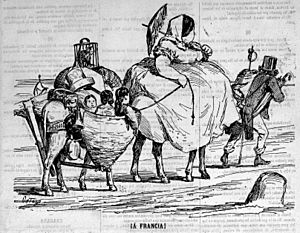
The queen's forces were defeated at the Battle of Alcolea on 28 September 1868. This ended Isabella II's 35-year rule. Isabella and her group left Spain by train on 30 September, going to Biarritz, France. Marshal Prim, the leader of the revolution, was welcomed by the people of Madrid. He gave a famous speech against the royal family.
Life After Being Queen
After leaving Spain, Isabella and her husband stayed in France. She officially gave up her rights to the throne in Paris on 25 June 1870, in favor of her son, Alfonso. This also involved an agreement about money.
After a new king, Amadeo of Savoy, was chosen for Spain, Isabella became friends again with her brother-in-law, the Duke of Montpensier.
The First Spanish Republic followed Amadeo's short rule. But in 1874, a military coup brought back the royal family. Isabella's son, Alfonso XII, became king.
After 1875, Isabella lived with her secretary, Ramiro de la Puente y González Nandín.
The main leader of the new government, Cánovas del Castillo, believed that Isabella's presence in Spain would cause problems. He told her that Spain needed a new era.
She returned to Spain in July 1876 but was only allowed to visit Madrid for a few hours. She then moved to Seville and left for France in 1877. Isabella's son married Mercedes of Orléans in 1878, but she died five months later.
Isabella lived most of the rest of her life in Paris, at the Palacio Castilla. She visited Seville a few times. She wrote her will in Paris in 1901, asking to be buried in El Escorial. She died on 9 April 1904, at the age of 73. Her body was taken to El Escorial and buried there on 15 April.
Children
Isabella had twelve pregnancies, but only five of her children lived to adulthood:
- Infanta María Isabel (1851–1931): She married her cousin, Prince Gaetan, Count of Girgenti.
- Alfonso XII of Spain (1857–1885): He became the future King of Spain.
- Infanta María del Pilar (1861–1879).
- Infanta María de la Paz (1862–1946): She married her cousin, Prince Louis Ferdinand of Bavaria.
- Infanta María Eulalia (1864–1958): She married her cousin, Infante Antonio d'Orléans, Duke of Galliera.
All of Isabella's children were recognized by her husband, Francisco de Asís.
Nicknames
Isabella II was known by a few nicknames:
- The Traditional Queen (: la Reina Castiza): This was because she liked traditional Spanish culture.
- The Queen of Sad Mischance (: la de los Tristes Destinos): This nickname came from a play by Shakespeare and was used to describe her difficult reign.
Honours
Isabella II received many awards and honours from Spain and other countries:
 Spain: Dame of the Order of Queen Maria Luisa, 10 October 1830
Spain: Dame of the Order of Queen Maria Luisa, 10 October 1830 Austria: Knight Grand Cordon with Collar of the Royal Hungarian Order of Saint Stephen
Austria: Knight Grand Cordon with Collar of the Royal Hungarian Order of Saint Stephen Austria: Dame of the Order of the Starry Cross, 1st Class
Austria: Dame of the Order of the Starry Cross, 1st Class Brazil: Knight Grand Cordon of the Imperial and Royal Order of Christ
Brazil: Knight Grand Cordon of the Imperial and Royal Order of Christ Brazil:: Knight Grand Cordon with Collar of the Imperial and Royal Order of the Southern Cross, 1848
Brazil:: Knight Grand Cordon with Collar of the Imperial and Royal Order of the Southern Cross, 1848- France
 Bourbon-French Royal Family: Knight Grand Cross of the Royal Order of the Holy Spirit
Bourbon-French Royal Family: Knight Grand Cross of the Royal Order of the Holy Spirit Bourbon-French Royal Family: Knight Grand Cross with Collar of the Royal Order of Saint Michael
Bourbon-French Royal Family: Knight Grand Cross with Collar of the Royal Order of Saint Michael French Imperial Family: Knight Grand Cordon with Collar of the Imperial Order of the Legion of Honour
French Imperial Family: Knight Grand Cordon with Collar of the Imperial Order of the Legion of Honour
 Bavaria: Knight Grand Cross with Chain of the Order of Saint Hubert
Bavaria: Knight Grand Cross with Chain of the Order of Saint Hubert Bavaria: Dame Grand Cross of the Order of Theresa
Bavaria: Dame Grand Cross of the Order of Theresa Bavaria: Dame Grand Cross of the Order of Saint Elizabeth
Bavaria: Dame Grand Cross of the Order of Saint Elizabeth Saxe-Weimar-Eisenach: Knight Grand Cross of the Order of the White Falcon, 1 November 1861
Saxe-Weimar-Eisenach: Knight Grand Cross of the Order of the White Falcon, 1 November 1861 Saxony: Knight Grand Cross of the Order of the Rue Crown
Saxony: Knight Grand Cross of the Order of the Rue Crown Saxony: Dame Grand Cross of the Order of Sidonia
Saxony: Dame Grand Cross of the Order of Sidonia Saxony: Dame of the Order of Maria-Anna, Special Class
Saxony: Dame of the Order of Maria-Anna, Special Class Greece: Knight Grand Cross of the Order of the Redeemer
Greece: Knight Grand Cross of the Order of the Redeemer- Italy
 Italian Royal Family: Knight Grand Collar of the Supreme Order of the Most Holy Annunciation
Italian Royal Family: Knight Grand Collar of the Supreme Order of the Most Holy Annunciation Italian Royal Family: Knight Grand Cordon of the Order of Saints Maurice and Lazarus
Italian Royal Family: Knight Grand Cordon of the Order of Saints Maurice and Lazarus Italian Royal Family: Knight Grand Cordon of the Order of the Crown of Italy
Italian Royal Family: Knight Grand Cordon of the Order of the Crown of Italy Holy See: Knight Grand Cross with Collar of the Supreme Order of Christ
Holy See: Knight Grand Cross with Collar of the Supreme Order of Christ Two Sicilian Royal Family: Knight Grand Cross with Collar of the Order of Saint Januarius
Two Sicilian Royal Family: Knight Grand Cross with Collar of the Order of Saint Januarius Two Sicilian Royal Family: Bailiff Knight Grand Cross with Collar of the Two Sicilian Sacred Military Constantinian Order of Saint George
Two Sicilian Royal Family: Bailiff Knight Grand Cross with Collar of the Two Sicilian Sacred Military Constantinian Order of Saint George
- Mexico
 Monaco: Knight Grand Cross of the Order of Saint-Charles, 17 September 1865
Monaco: Knight Grand Cross of the Order of Saint-Charles, 17 September 1865 Portugal: Knight Grand Cross of the Order of the Immaculate Conception of Vila Viçosa, 23 June 1834
Portugal: Knight Grand Cross of the Order of the Immaculate Conception of Vila Viçosa, 23 June 1834 Portugal: Knight Grand Cross with Collar of the Order of the Tower and Sword
Portugal: Knight Grand Cross with Collar of the Order of the Tower and Sword Portugal: Dame Grand Cross of the Order of Saint Isabel
Portugal: Dame Grand Cross of the Order of Saint Isabel
Places Named After Her
Several places and structures were named in her honour:
 Philippines:
Philippines:
- Cavite: Bridge of Isabel II
- Isabela (province)
- Manila: El Banco Español Filipino de Isabel II, which is now the Bank of the Philippine Islands.
 Puerto Rico:
Puerto Rico:
- Isabel II: a town in Vieques, Puerto Rico.
In Films
- In the 1997 movie Amistad, Isabella II was played by Anna Paquin. She was shown as an 11-year-old girl.
See also
 In Spanish: Isabel II de España para niños
In Spanish: Isabel II de España para niños
- Isabela province in the Philippines.
- Mid-19th-century Spain
- Spain under the Restoration
- Plaza de Isabel II (Santa Cruz de Tenerife)


